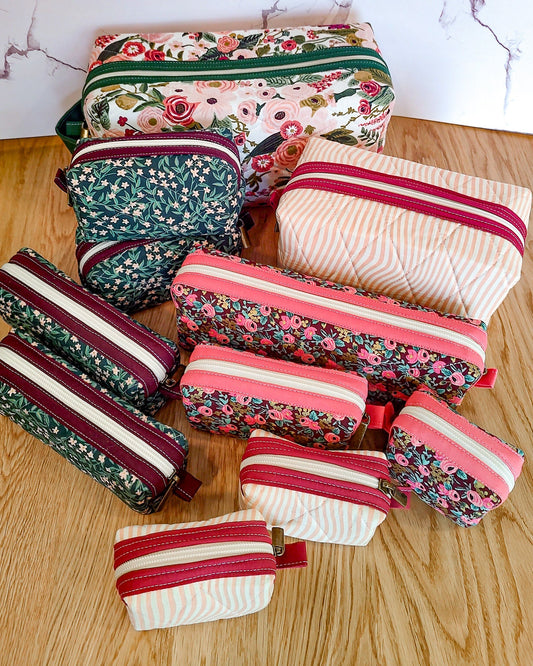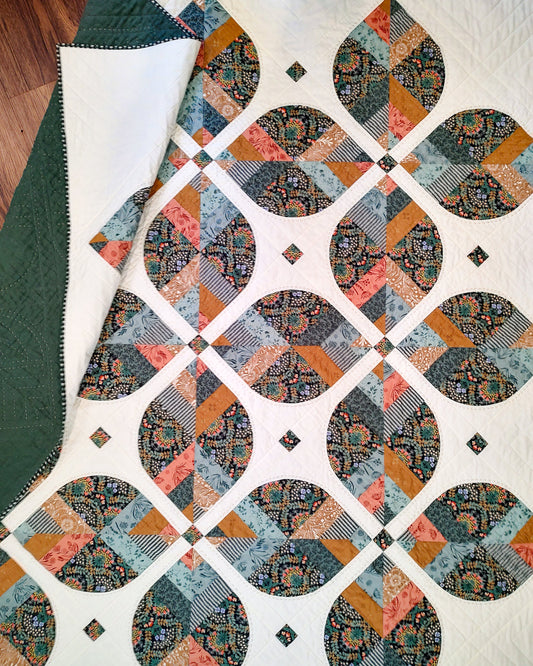Quilt Binding 101 - Binding with your machine
Welcome to the most thorough tutorial you may ever read about machine binding your finished quilt! For those of you who learn best with words and pictures, this is for you, and written for beginners to be able to follow along.
For those of you who prefer video - that's in the works and coming soon!
This tutorial jumps from where we left off in the Quilt Binding 101 - Preparing and attaching your binding strips. If you need guidance on how to cut, press, join, and attach your binding strips to your quilt, start there.

Machine Stitching
Pros:
- Fast and easy - I can usually get a quilt machine stitched down once the binding is on in 30 minutes or less. It takes me daaaaaays to hand stitch a binding, and I just don't always have time for that!
- Ultra-secure - hand stitches are secure, don't get me wrong. But some quilters prefer to machine bind just to make ultra-ultra sure the baby quilt that gets washed every other day will hold up.
- I personally like the uniformly finished look of machine stitches. Granted, that is very subjective, but I like it.
Cons:
- The biggest con is your stitches will show somewhere on your quilt. For many quilters, this is a deal-breaker and they choose to hand-stitch. I always choose a thread that matches the front fabric, and might choose to hand stitch a quilt if I think the stitches showing will bother me.
For a quilt with a white border, I machine stitch with white thread and the stitch line is barely noticeable to me after washing. I have found that machine stitching with 2 1/4" binding strips provides me the best ratio of ease of stitching vs. visible stitch line while working with low-loft batting and minky. If you choose to machine stitch, you may develop different preferences over time based on the fabrics you typically work with.
I almost always machine stitch from the back - there is no right or wrong way, I'm just very picky about how the stitch line looks on the back, so I stitch so I can see it and that's the method I'll teach here for simplicity. As stated in the previous tutorial, Cait does her machine binding totally different, she uses methods that work best for her hands and her machine and her preferences that are different then mine.
Here at TJT Headquarters we have stitched down bindings just about every which way you can possibly imagine as we have tried and tested, learned and evolved our own styles and skills and to meet the design needs of individual quilts.
I digress - pick up that quilt, with the binding strips attached, and let's get started!
First, fold the binding over so the fold is in back - hiding the raw edges - and secure it. I love Clover clips but some folks use old school hair clips, pins, glue (with a quick iron to set it), or hem tape.

At the corners, fold the binding into a miter and either clip or pin the fold so it stays in place. Again - don't worry if you didn't get a perfect miter! It's taken a lot of practice to get consistent miters in my corners. And bulkier quilts or minky backs make that even more challenging.


Sometimes I'll clip the entire quilt if it's small, other times I'll just clip one side at a time. I prefer using my walking foot to prevent the binding from shifting on me. Starting with a few backstitches, sew down the edge with whatever seam allowance you'd like (I hug the very edge of the binding, like a traditional top-stitch).

When I get to a corner, I'll unclip and hold the miter with my fingernail...or preferably, leave a pin in place and stitch right over it - which is exactly what I did after taking this picture and reprimanding myself for knowing better when the fabric shifted.

I like to give it a little backstitch then pivot in the needle-down position and do a little back-and-forth again to secure everything in place. Keep going all the way around until you're finished!
Here's a close-up picture of my stitch line from the front of my unwashed quilt, and a few examples of the stitch line in a washed and freshly crinkled quilt.



Remember - there's no rules! If you want to machine bind and don't want to see the stitch line on your blocks, attach your binding to the back and stitch it down on the front of the quilt instead! Cait did that on this Abode Calendula quilt when we used the 2.5 Edition AGF binding strips.

Wrapping it up...
In my experience, binding seems to be the area where new quilters are the most unsure of themselves. Largely because there are several different methods and preferences out there and it takes some time before you develop you own! (Don't even get me started on the Quilt Police...) My hope is by teaching you 1-2 methods it gives you a confident place to begin, and the rest will follow.
Happy sewing!
Rebecca











